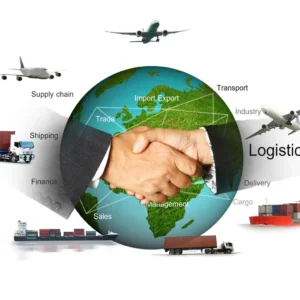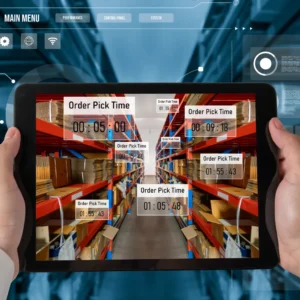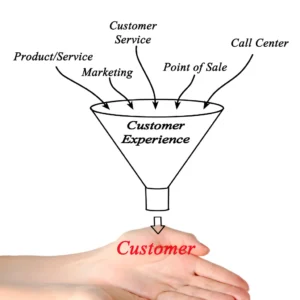
Revolutionizing Logistics
AI Tools for Precision Route Optimization and Planning in the Industry
In the fast-paced world of logistics, the integration of cutting-edge technology is paramount for streamlined operations. The focal point of this discussion revolves around “AI Tools for Route Optimization and Planning in the Logistics Industry.”
As an AI pioneer specializing in Transportation and logistics, adopting advanced solutions is the key to unlocking unprecedented efficiency, cost savings, and customer satisfaction.
These AI-powered tools, including Route Planning, Real-Time Traffic and Weather Updates, Dynamic Fleet Management, Last-Mile Delivery Optimization, and Automated Load Balancing, collectively aim to revolutionize the intricacies of logistics operations.
This comprehensive suite of tools promises to redefine how businesses navigate challenges, optimize resources, and deliver goods promptly in an increasingly dynamic and competitive logistics landscape.
Table of Contents
5 AI Tool ideas for Route Optimization and Planning
AI-Powered Route Planning:
This tool uses AI algorithms to optimize delivery routes based on historical data and current traffic conditions. It helps minimize travel time, fuel consumption, and overall transportation costs.
Real-Time Traffic and Weather Updates:
Real-time traffic and weather data integration is crucial for accurate and dynamic route planning. This tool ensures that your system can adapt to changing conditions on the road, providing more accurate ETAs and helping drivers avoid delays.
Dynamic Fleet Management:
Fleet management involves overseeing various tasks, such as vehicle maintenance, driver scheduling, and asset tracking. The dynamic aspect of this tool suggests that it can adapt in real time to changing circumstances, ensuring optimal resource allocation and utilization.
Last-Mile Delivery Optimization:
Last-mile delivery is often the most challenging and expensive logistics process. This tool focuses on optimizing the final leg of the delivery journey, aiming to reduce costs, improve delivery times, and enhance customer satisfaction.
Automated Load Balancing:
Efficient load balancing is essential for maximizing available resources and minimizing operational costs. This tool automates distributing loads among available vehicles, ensuring a balanced and optimized distribution of goods.
AI-Powered Route Planning
Building an AI-powered Route Optimization and Planning tool for the Transportation and Logistics Industry requires careful consideration of various aspects. Let’s delve into each of the mentioned points:
Business Knowledge Requirements:
It is essential to have a profound comprehension of this project’s transportation and logistics sector. This includes knowledge of supply chain management, fleet operations, regulatory requirements, and customer expectations. Additionally, understanding the specific challenges faced by logistics companies, such as congestion, delivery time constraints, and cost optimization, is crucial.
Software Requirements:
- AI Algorithms and Models: Implement advanced machine learning algorithms to analyze historical data and predict optimal routes.
- Geospatial Data Processing: Utilize geospatial data to accurately map routes, considering factors like road conditions, traffic patterns, and infrastructure.
- Real-Time Data Integration: Incorporate APIs for real-time traffic updates, weather conditions, and other relevant information.
- User Interface (UI) and User Experience (UX): Create a user-friendly interface for inputting data, optimizing routes, and providing real-time updates.
- Security Measures: Implement robust security protocols to protect sensitive logistics and route information.
Hardware Requirements:
- Powerful Computing Resources: High-performance servers or cloud computing infrastructure to handle the computational load of AI algorithms.
- Data Storage: Sufficient storage capacity to store and process large volumes of historical and real-time data.
Integration Requirements to Existing Toolset:
Integrating the new tool with existing systems is critical for seamless operations. This may involve linking with ERP systems, fleet management software, and other logistics tools to ensure a unified and efficient workflow.
Training Required for Existing Staff:
Training programs should be designed to familiarize staff with the new tool. Knowing how to enter data accurately, understand suggested routes, and use real-time updates is essential. Training may also cover troubleshooting and handling exceptional scenarios.
Challenges and Workarounds in Implementing the Tool:
- Data Quality and Consistency:
- Challenge: Inconsistent or poor-quality data can lead to inaccurate route planning.
- Workaround: Implement data validation and cleansing mechanisms to enhance data quality.
- Adoption Resistance:
- Challenge: Employees may resist the adoption of new technology.
- Workaround: Involve your staff in the development process, provide them with comprehensive training, and emphasize the benefits of the new tool.
Similar Tools Already Available in the Market:
Several route optimization tools exist, such as Route4Me, OptimoRoute, and Descartes Systems Group. These tools often offer varying features and levels of customization. Analyzing competitors can provide insights into market trends, user preferences, and potential gaps to address in your tool.
Cost and Benefit Analysis:
- Costs:
- Development Costs: Expenses related to hiring skilled developers, data scientists, and AI experts.
- Infrastructure Costs: Investment in servers or cloud services for hosting and processing data.
- Training Costs: Budget for training programs to educate staff on using the new tool.
- Benefits:
- Cost Savings: Reduced fuel consumption, minimized travel time, and optimized routes lead to cost savings.
- Improved Efficiency: Enhanced logistics operations result in quicker deliveries and improved overall efficiency.
- Customer Satisfaction: Timely and optimized deliveries contribute to increased customer satisfaction.
Recommendation: Build from Scratch
Considering your organization’s specialization in the Transportation and Logistics Industry, building the tool from scratch is recommended. This approach allows for tailored solutions addressing industry-specific challenges. It will enable seamless integration with existing tools and customization of AI algorithms to fit unique organizational requirements. While off-the-shelf solutions offer a quicker implementation, they may need more customization for optimal performance in your specific business context.
Building from scratch allows for a more personalized and innovative solution, aligning closely with your organization’s goals and requirements. Additionally, it positions your company as a pioneer in leveraging AI for Transportation and logistics, potentially providing a competitive edge in the market. The long-term benefits of a custom-built solution often outweigh the initial development costs.
In summary, given the intricate nature of the Transportation and Logistics Industry, building the AI-powered Route Optimization and Planning tool from scratch is the recommended approach for your organization.
Real-Time Traffic and Weather Updates
Building a Real-Time Traffic and Weather update AI tool for Route Optimization and Planning in the Logistics Industry requires careful consideration of various aspects. Let’s delve into each of the mentioned points:
Business Knowledge Requirements:
- Transportation and Logistics Industry Expertise: In-depth knowledge of industry-specific challenges, regulations, and operational processes is essential.
- Understanding of Route Planning: Familiarity with route optimization techniques, factors affecting Transportation, and the impact of real-time data on delivery schedules.
Software Requirements:
- Real-Time Data Integration: Implement APIs to connect with reliable, up-to-date traffic and weather data sources.
- Data Processing and Analytics: Develop algorithms for processing and analyzing real-time data to provide actionable insights.
- User Interface for Visualization: Design a user-friendly interface that allows users to visualize real-time updates and make informed decisions.
- Communication Protocols: Implement communication protocols for seamless data exchange between the real-time updates tool and the route optimization system.
Hardware Requirements:
- High-Performance Servers or Cloud Infrastructure: Robust servers or cloud services to handle the processing load of real-time data and ensure optimal system performance.
Integration Requirements to Existing Toolset:
- API Integration: Ensure seamless integration with the AI-powered Route Optimization and Planning tool, allowing the exchange of data in real time.
- Compatibility with Fleet Management Systems: Integrate with existing fleet management systems to synchronize route planning with vehicle tracking and scheduling.
Training Required for Existing Staff:
- Data Interpretation and Decision-Making: Training staff to analyze real-time traffic and weather data and utilize insights to make informed decisions is essential.
- System Usage and Navigation: Provide training on using the tool’s interface and navigating through real-time updates.
Challenges and Workarounds in Implementing the Tool:
- Data Accuracy and Reliability:
- Challenge: Real-time data may need to be more accurate or reliable.
- Workaround: Implement data validation mechanisms and incorporate multiple data sources to cross-verify information.
- Integration Complexity:
- Challenge: Integrating real-time updates seamlessly with existing tools can be complex.
- Workaround: Collaborate closely with IT teams and software developers to ensure smooth integration and conduct thorough testing.
Similar Tools Already Available in the Market:
Several tools in the market provide real-time traffic and weather updates for logistics and Transportation. Examples include HERE Technologies, TomTom Telematics, and Waze for real-time traffic updates. For weather information, services like The Weather Company and AccuWeather offer APIs for integration.
Cost and Benefit Analysis:
- Costs:
- Development Costs: Investment in developing the real-time traffic and weather updates tool, including software development, data integration, and testing.
- Data Subscription Costs: Costs associated with subscribing to reliable real-time data sources.
- Benefits:
- Improved Route Accuracy: Real-time updates enhance route accuracy, reducing travel time and fuel costs.
- Adaptability to Changing Conditions: The tool allows for dynamic route planning, enabling drivers to avoid delays caused by unexpected traffic or adverse weather conditions.
- Enhanced Customer Satisfaction: Accurate ETAs and on-time deliveries improve customer satisfaction.
Recommendation: Integrate with Available Market Products
Given your organization’s specialization in the Transportation and Logistics Industry and the need for seamless integration with the existing Route Optimization tool, a recommended approach would be to Integrate with Similar Available Products.
- Customization and Compatibility: Integrating with an existing tool ensures compatibility and synergy with the AI-powered Route Optimization and Planning tool developed in-house.
- Time and Cost Efficiency: Integrating with established products can be more time and cost-efficient than developing a real-time updates tool from scratch.
- Leveraging Specialized Expertise: Utilize the expertise of established providers specializing in real-time traffic and weather data, ensuring reliable and accurate information.
- Focus on Core Competencies: This approach allows your organization to focus on its main strength of AI-powered route optimization while leaving real-time updates to specialists in that field.
In conclusion, integrating existing products specializing in real-time traffic and weather updates offers a balanced approach, leveraging external expertise while maintaining compatibility with your in-house AI tools. This strategy can lead to a more efficient and cost-effective implementation while ensuring a robust and well-integrated solution for the Transportation and Logistics Industry.
Dynamic Fleet Management
Building a Dynamic Fleet Management AI tool for Route Optimization and Planning in the Logistics Industry requires thorough consideration of various aspects. Let’s explore each point in detail:
Business Knowledge Requirements:
- Fleet Management Expertise: In-depth knowledge of fleet management practices, regulatory requirements, and industry-specific challenges.
- Understanding of Operational Dynamics: Familiarity with the operational dynamics of Transportation, including vehicle maintenance, driver scheduling, and asset tracking.
Software Requirements:
- Real-Time Data Processing: Implement real-time data processing capabilities for dynamic decision-making.
- Predictive Analytics: Integrate predictive analytics to foresee maintenance needs, optimize scheduling, and adapt to changing circumstances.
- Driver and Asset Tracking: Develop features for real-time tracking of drivers and assets, ensuring visibility and accountability.
- Communication and Collaboration Tools: Implement communication tools for seamless interaction between fleet managers, drivers, and maintenance teams.
Hardware Requirements:
- Robust Server Infrastructure or Cloud Services: High-performance servers or cloud infrastructure to handle the computational load of real-time data processing and analytics.
Integration Requirements to Existing Toolset:
- Integration with Route Optimization Tool: Ensure seamless integration with the AI-powered Route Optimization and Planning tool for synchronized operations.
- Compatibility with Maintenance Systems: Integrate with existing maintenance systems to streamline vehicle maintenance schedules based on real-time data.
Training Required for Existing Staff:
- System Navigation and Usage: Train staff on using the Dynamic Fleet Management tool, including navigation, data input, and interpretation of real-time information.
- Decision-Making in Dynamic Scenarios: Provide training on making informed decisions in dynamic situations, leveraging the real-time adaptability of the tool.
Challenges and Workarounds in Implementing the Tool:
- Data Accuracy and Consistency:
- Challenge: Inaccurate or inconsistent data may lead to suboptimal decision-making.
- Workaround: Implement data validation mechanisms and ensure regular updates and maintenance of data sources.
- Driver Adoption and Resistance:
- Challenge: Drivers may resist adopting new technologies or changes in scheduling.
- Workaround: Communicate the tool’s benefits, involve drivers in the implementation process, and provide training and support.
Similar Tools Already Available in the Market:
Several tools in the market offer dynamic fleet management capabilities. Examples include Trimble Transportation, Geotab, and Samsara. These tools often provide real-time tracking, predictive maintenance, and driver management features.
Cost and Benefit Analysis:
- Costs:
- Development Costs: Investment in the Dynamic Fleet Management tool, including software development, integration, and testing.
- Infrastructure Costs: Maintaining high-performance servers or cloud services for real-time data processing is expensive.
- Benefits:
- Optimized Resource Utilization: Dynamic adaptability leads to optimized resource allocation, minimizing idle time and maximizing efficiency.
- Reduced Maintenance Costs: Predictive analytics and real-time monitoring can help reduce maintenance costs by addressing issues before they become critical.
- Enhanced Operational Efficiency: Improved scheduling and communication improve operational efficiency and on-time deliveries.
Recommendation: Integrate with Available Market Products
Given your organization’s specialization in the Transportation and Logistics Industry and the need for seamless integration with the existing Route Optimization tool, a recommended approach would be to Integrate with Similar Available Products.
- Leverage Existing Expertise: Integrate with established fleet management solutions specializing in dynamic adaptability and real-time optimization.
- Cost and Time Efficiency: Integrating with pre-existing products can save time and costs compared to developing a fleet management tool from scratch.
- Comprehensive Solutions: Utilize solutions that offer a comprehensive set of features, including real-time tracking, predictive analytics, and communication tools.
- Focus on Core Competencies: This approach allows your organization to focus on enhancing the core features of your AI-powered Route Optimization and Planning tool while leveraging the expertise of existing solutions for dynamic fleet management.
In conclusion, integrating with existing products specializing in dynamic fleet management offers a balanced approach, ensuring compatibility with your in-house AI tools and leveraging the capabilities of established solutions in the market. This strategy can lead to a more efficient and cost-effective implementation, providing a robust and well-integrated solution for the Transportation and Logistics Industry.
Last-Mile Delivery Optimization
Building a Last-Mile Delivery Optimization AI tool for Route Optimization and Planning in the Logistics Industry requires a comprehensive understanding of the business, advanced software capabilities, and strategic decision-making. Let’s explore each aspect in detail:
Business Knowledge Requirements:
- Last-Mile Delivery Challenges: In-depth knowledge of the unique challenges associated with last-mile delivery, such as congested urban areas, delivery time constraints, and customer expectations.
- Customer Satisfaction Dynamics: Understanding customer expectations for on-time and convenient last-mile deliveries is crucial.
- Regulatory Compliance: Awareness of local regulations and restrictions affecting last-mile delivery operations.
Software Requirements:
- Route Optimization Algorithms: Advanced algorithms to optimize delivery routes based on real-time data, customer locations, and delivery time windows.
- Geospatial Analytics: Integrating geospatial analytics for accurate mapping and navigation in urban areas.
- Real-Time Data Integration: Integration with real-time traffic, weather, and order status data for dynamic adjustments.
- Customer Communication Tools: Tools for real-time customer communication, including delivery notifications and tracking options.
Hardware Requirements:
- High-Performance Servers or Cloud Infrastructure: Robust computing infrastructure to handle the computational load of route optimization algorithms and real-time data processing.
Integration Requirements to Existing Toolset:
- Integration with Route Planning Tool: Seamless integration with the AI-powered Route Optimization and Planning tool to ensure a unified approach.
- Connectivity with Order Management Systems: Integration with existing order management systems for real-time order status and data exchange.
- Communication with Customer Support Systems: Integration with customer support systems to handle queries and issues related to last-mile deliveries.
Training Required for Existing Staff:
- Usage of Last-Mile Optimization Tool: Training programs to educate delivery staff on using the tool for efficient last-mile deliveries.
- Customer Communication Training: Training on effective customer communication through the tool, including delivery notifications and updates.
Challenges and Workarounds in Implementing the Tool:
- Urban Navigation Challenges:
- Challenge: Navigating through congested urban areas can be challenging.
- Workaround: Utilize advanced geospatial analytics and real-time traffic data to optimize routes dynamically.
- Delivery Time Windows:
- Challenge: Meeting specific delivery time windows.
- Workaround: Implement flexible delivery time slot options and real-time customer communication for updates.
Similar Tools already available in the market:
Several tools in the market focus on last-mile delivery optimization. Examples include Bringg, Postmates, and Onfleet. These tools provide real-time tracking, route optimization, and customer communication for the final delivery stage.
Cost and Benefit Analysis:
- Costs:
- Development Costs: Investment in the Last-Mile Delivery Optimization tool, including software development, algorithm implementation, and testing.
- Data Integration Costs: Expenses related to integrating real-time data sources and existing systems.
- Development Costs: Investment in the Last-Mile Delivery Optimization tool, including software development, algorithm implementation, and testing.
- Benefits:
- Cost Reduction: Optimized routes reduce fuel costs and operational expenses in the last-mile delivery process.
- Improved Delivery Times: Faster and more efficient last-mile deliveries improve delivery times and customer satisfaction.
- Enhanced Customer Satisfaction: Real-time communication and accurate delivery predictions enhance customer satisfaction.
- Cost Reduction: Optimized routes reduce fuel costs and operational expenses in the last-mile delivery process.
Recommendation: Integrate with Available Market Products
Given your organization’s specialization in the Transportation and Logistics Industry and the need for seamless integration with the existing Route Optimization tool, a recommended approach would be to Integrate with Similar Available Products.
- Leverage Established Solutions: Integrate with existing last-mile delivery optimization solutions specializing in this specific logistics aspect.
- Time and Cost Efficiency: Using proven products for integration can save time and money compared to building a new optimization tool.
- Focus on Core Competencies: Concentrate on enhancing the core capabilities of your AI-powered Route Optimization and Planning tool while benefiting from the expertise of specialized last-mile solutions.
- Market Adoption and Feedback: Integrating with existing tools allows for quicker market adoption and immediate user feedback, facilitating continuous improvements.
In conclusion, integrating with existing last-mile delivery optimization products offers a balanced approach, ensuring compatibility with your in-house AI tools while benefiting from the specialized capabilities of established solutions. This strategy can lead to a more efficient and cost-effective implementation, providing a robust and well-integrated solution for the Last-Mile Delivery Optimization in the Transportation and Logistics Industry.
Automated Load Balancing
Building an Automated Load Balancing AI tool for Route Optimization and Planning in the Logistics Industry involves various considerations, ranging from business knowledge to technical requirements. Let’s explore each aspect in detail:
Business Knowledge Requirements:
- Understanding Logistics Operations: In-depth knowledge of logistics processes, including load management, vehicle capacities, and delivery constraints.
- Resource Optimization Expertise: One should know load-balancing principles to maximize available resources while keeping operational costs at a minimum.
- Compliance and Regulatory Knowledge: Awareness of regulations and compliance standards related to load distribution and Transportation.
Software Requirements:
- Load Balancing Algorithms: Development of sophisticated algorithms for automated load balancing based on factors like weight, volume, and delivery priorities.
- Real-Time Data Integration: Integration with real-time data sources for up-to-date information on vehicle capacities, load statuses, and delivery schedules.
- User Interface (UI): Development of an intuitive UI for users to input load data, visualize load balancing suggestions, and make informed decisions.
- Data Security Measures: Implementing robust security measures to protect sensitive load and route information.
Hardware Requirements:
- High-Performance Servers or Cloud Infrastructure: Adequate computing power for processing complex load-balancing algorithms and handling large volumes of data.
Integration Requirements to Existing Toolset:
- Integration with Route Optimization Tool: Seamless integration with the AI-powered Route Optimization and Planning tool to ensure coordinated load balancing and route planning.
- Compatibility with Fleet Management Systems: Integration with existing fleet management systems to synchronize load balancing decisions with overall fleet operations.
Training Required for Existing Staff:
- Tool Usage Training: Training programs to educate staff on using the Automated Load Balancing tool, inputting load data, and interpreting load balancing recommendations.
- Decision-Making in Load Distribution: Training on making informed decisions regarding load distribution based on the tool’s recommendations.
Challenges and Workarounds in Implementing the Tool:
- Data Accuracy and Reliability:
- Challenge: Inaccurate or unreliable load data can lead to suboptimal load-balancing decisions.
- Workaround: Implement data validation mechanisms and ensure data consistency across all integrated systems.
- Dynamic Load Changes:
- Challenge: Dynamic changes in load status during transit.
- Workaround: Implement real-time tracking and communication features to adjust load-balancing decisions based on changing conditions.
Similar Tools already available in the market:
Several tools in the market focus on load balancing and optimization in logistics. Examples include Oracle Transportation Management, Manhattan Associates’ Transportation Management System, and Descartes Systems Group. These tools offer features such as load planning, optimization, and real-time adjustments.
Cost and Benefit Analysis:
- Costs:
- Development Costs: Investment in the Automated Load Balancing tool, including software development, algorithm implementation, and testing.
- Infrastructure Costs: Expenses related to maintaining high-performance servers or utilizing cloud services for computation and storage.
- Benefits:
- Optimized Resource Utilization: Efficient load balancing leads to optimal use of available resources, minimizing fuel costs and operational expenses.
- Improved Delivery Efficiency: Balanced loads improve delivery times and overall operational efficiency.
- Enhanced Fleet Productivity: Automated load balancing allows quick and informed decisions, enhancing fleet productivity and reducing manual workload.
Recommendation: Integrate with Available Market Products
Given your organization’s specialization in the Transportation and Logistics Industry and the need for seamless integration with the existing Route Optimization tool, a recommended approach would be to Integrate with Similar Available Products.
- Leverage Established Solutions: Integrate with existing load-balancing solutions specializing in this specific logistics aspect.
- Time and Cost Efficiency: Using proven products for integration can save time and costs compared to building a load-balancing tool from scratch.
- Focus on Core Competencies: Concentrate on enhancing the core features of your AI-powered Route Optimization and Planning tool while benefiting from the expertise of established load-balancing solutions.
- Market Adoption and Feedback: Integrating with existing tools allows for quicker market adoption and immediate user feedback, facilitating continuous improvements.
In conclusion, integrating with existing load-balancing products offers a balanced approach, ensuring compatibility with your in-house AI tools while benefiting from the specialized capabilities of established solutions. This strategy can lead to a more efficient and cost-effective implementation, providing a robust and well-integrated solution for Automated Load Balancing in the Transportation and Logistics Industry.

Arindam Roy
An Automation Consultant with 25+ years of IT Experience
Conclusion
In conclusion, adopting AI tools for Route Optimization and Planning in the Logistics Industry offers significant benefits, with the overall recommendation being to integrate with similar available products. This approach ensures efficiency, minimizes development costs and capitalizes on the expertise of established solutions. To improve data accuracy and reliability, implement robust data validation mechanisms, involve employees in development, and offer comprehensive training.
The seamless integration of AI-powered Route Planning, Real-Time Traffic and Weather Updates, Dynamic Fleet Management, Last-Mile Delivery Optimization, and Automated Load Balancing tools provides a holistic solution. It optimizes routes, dynamically adapts to changing conditions, efficiently balances loads, and enhances delivery. The cost and benefit analysis demonstrates potential cost savings, improved operational efficiency, and heightened customer satisfaction.
As an AI pioneer in the Transportation and Logistics Industry, this integrated approach positions the organization for success, fostering innovation and maintaining a competitive edge in the ever-evolving logistics landscape. By leveraging existing tools and technologies, the organization can swiftly adapt to market demands, enhance operational processes, and deliver superior services to clients, solidifying its role as a leader in AI-driven logistics solutions.
Related Articles
- AI Tools for Predictive Analytics and Business Intelligence
- AI Tools for Sustainability and Green Logistics
- AI Tools for Compliance and Regulatory Support
- AI Tools for Fleet Maintenance and Monitoring
- AI Tools for Operational Efficiency and Automation
- AI Tools for Supply Chain Visibility and Collaboration
- AI Tools for Order and Shipment Tracking
- AI Tools for Warehouse Management and Automation
- AI Tools for Risk Management and Security
- AI tools in the Transportation and Logistics industry































